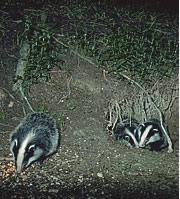 Moving around in search of a mate helps spread disease.Corbis
Moving around in search of a mate helps spread disease.CorbisCulling badgers to reduce the incidence of bovine tuberculosis (TB) among farm cattle may in fact worsen the spread of the disease, according to a study of the disease's prevalence among different badger groups.
British government researchers surveyed more than 1,800 badgers and found that low rates of TB correspond with low levels of badger migration between groups. As culling disturbs badgers and makes them more mobile, the discovery suggests that culling would spread disease.
The latest finding looks set to boost the arguments against culling of wild badgers. Besides the ethical objections, doubts have been raised over its effectiveness.
British badgers (Meles meles) were first culled in 1973 as a means of controlling bovine TB, but the number of cases among cattle continued to rise. In 1998, the government launched an evaluation of the effectiveness of different culling strategies.
That project, called the Randomised Badger Culling Trial, suffered a setback in 2003, when officials realized that 'reactive culling', one of the strategies being tested, was actually exacerbating the spread of the disease (see 'UK halts TB trial'). The other strategy, 'proactive culling', continued until the trial's scheduled end in 2006.
ADVERTISEMENT
The British government does not currently cull badgers to restrict TB. "The whole question of badger culling is up in the air," says Richard Delahay, a wildlife disease specialist at the UK Central Science Laboratory at Woodchester Park, Gloucestershire, who took part in the new research. "If the decision is taken to go ahead the consideration must go towards minimizing these effects."
Do not disturb
In the latest study, Delahay and his colleagues trapped all the badgers living near Woodchester Park several times a year, from 1990 to 2004, to build up a record of their movements and TB prevalence. The population was not part of any culling trial.
Higher rates of movement are associated with greater chance of infection, the researchers report in the Journal of Animal Ecology1.
"There does seem to be a statistical association," says Neil Walker, another member of the team. "But it is unclear what the direction of those dynamics is — whether infections lead to increased movement, or increased movement leads to infections."
Badgers move even when not disturbed — males go in search of a mate, for example. But disturbing populations, which also occurs as a result of culling, is known to increase such movements, partly by fragmenting family units.
TB is currently controlled by restricting cattle movements, and by testing cows. It remains to be seen whether culling will make a comeback, says Delahay. "It's likely that a successful control policy will have many components," he says. "Balancing those options is a job for policymakers."
Visit our cullingmayincreasetb.html">newsblog to read and post comments about this story.
